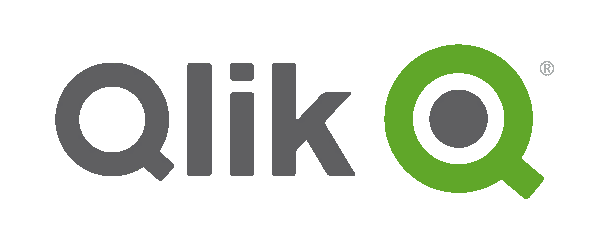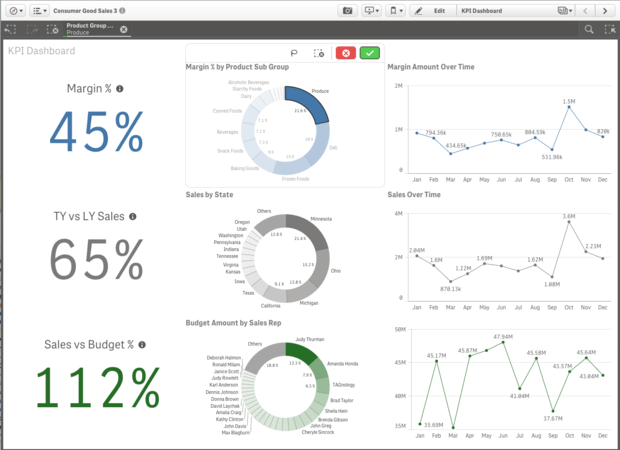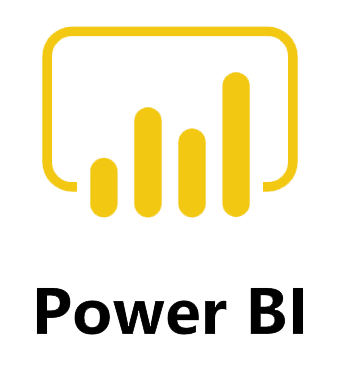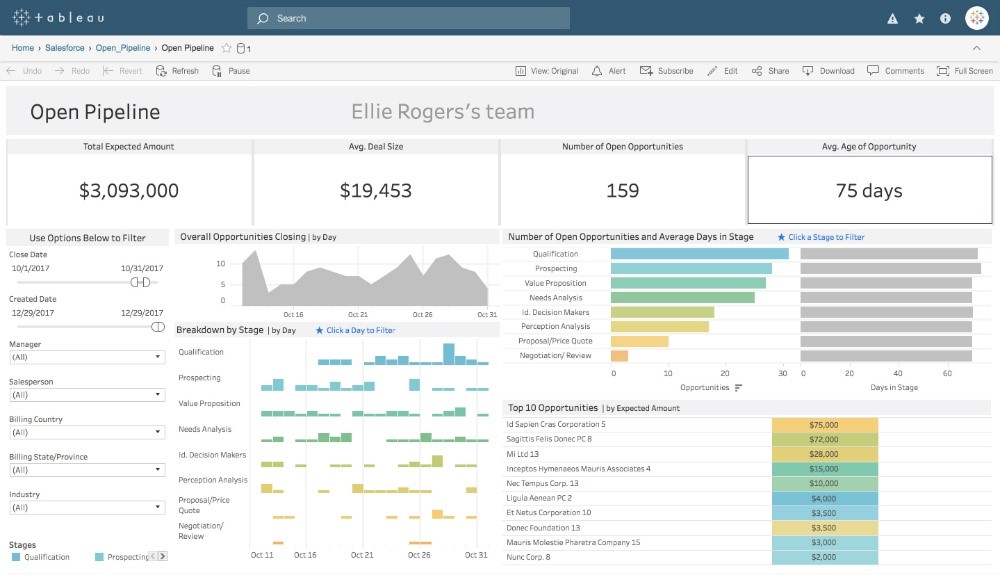At this moment in time, the responsibility for analytics has shifted from IT staff to business analysts, database administrators, and data scientists. Thus, BI has gone from generating monthly reports from the record system to interactively creating and sharing forecasts and responding to business questions based on data from an extensive range of internal and external data sources. Before, businesses made decisions in a month. Now, thanks to self-service BI, they can take action in just a few days.
The problem is with the abundance of BI platforms available on the market today, it’s not easy to choose one that will suit your business needs perfectly. In this blog post we won’t be talking about tons of different BI tools but focus only on the heavyweights of self-service BI – Qlik Sense, Microsoft’s Power BI, Tableau. We’ll analyze and compare some of their main parameters to help you decide which one will be the most useful for your organization.
Qlik Sense

Qlik is the leading visual analytics platform and the forerunner of user-driven business intelligence. Its portfolio of cloud-based and on-premise solutions meet the growing customers’ demands ranging from reporting and self-service visual analysis to guided, embedded, and custom analytics, regardless of where data is stored. Qlik users gain meaningful insights exploring the hidden relationships within data from multiple sources. A fully integrated cloud platform, Qlik is powered by its unique in-memory associative data indexing (QIX) engine. Qlik’s Associative engine identifies and assembles all your data so you can explore without limits. This is easily the most powerful competitive advantage in a data-driven world.
Intuitive visualization and exploration, advanced analytics, and self-service data preparation abilities allow Qlik Sense to combine enterprise governance and readiness enabling organizations to manage the range of BI use cases from a single platform.
Let’s explore some of the key features of Qlik Sense:
Smart visualizations and analytics

Qlik Sense is not just a visualization tool. It offers advanced and intelligent visualizations that enhance the process of data analysis. The visualizations are interactive, flexible, and adjustable, with the first-rate graphics. There are many great visualizations types available like Distribution chart, Box plot, and Histogram that help users better understand their data. Users can also improve consistency in their application by applying custom coloring filters to data values within the master dimensions.
Conversational analytics and NLP
Thanks to the open API’s, Qlik has integration with the natural language generation & processing, advanced predictive analytics, and augmented intelligence. These capabilities make possible direct data exchange between third-party and QIX engine for calculations. Based on this interface, Qlik has released integrations for R and Python as well. As a result, users can visualize advanced calculations from external tools within Qlik Sense. But what’s more, Qlik users can combine the power of Qlik’s associative model with advanced analytics to support use cases like- sales forecasting, inventory management, and fraud detection.
Data storytelling and reporting
Data storytelling is one of the most powerful and unique features of Qlik Sense. It gives intelligent and in-context commentary on the data analytics visuals. The software creates the entire data story that puts things into perspective and paints a picture that will be presented for the analysis. It’s very helpful for drawing actionable insights from the data. The apps created in Qlik Sense in the form of reports can be printed or exported in Excel, PowerPoint, PDF, or other formats.
Mobility
Qlik Sense was created with the mobility feature in mind. With its native touch interaction and responsive design, it allows you to explore analytics and collaborate with your team using any device. Moreover, you can experience fully interactive offline analysis on iOS, and it also supports leading Enterprise Mobility Management (EMM) platforms.
Scalability and governance
Qlik provides enterprise-class management services that guarantee data safety, control, monitoring, and centralized management. The centralized data monitoring and management are done via the Qlik Management Console (QMC) which controls all the Qlik Sense services centrally. Scalability is another crucial aspect. Elastic scaling in Qlik Sense helps to load and analyze a large amount of data.
Qlik Data Catalyst (QDC) and Attunity
Today’s hyper-competitive environment, where real-time enterprise data is indispensable to success, calls for a more agile approach to analytics and data integration. Qlik fuses Attunity’s data integration solutions with the data management and cataloging solutions of Qlik Data Catalyst and offers users an enterprise data integration platform to convert their raw data into a governed, analytics-driven information resource. This platform encourages the movement of data in real-time across multiple cloud environments and data lakes. When combined with predictive analytics and AI, it scales real-time insights throughout an entire organization.
Qlik Insight Bot (QIB)
Qlik Insight Bot offers a fast and simple way to ask questions and discover insights to make data-driven decisions just by having a conversation. With each question, the Qlik Insight Bot engages users and instantly brings up relevant charts and insights, including key drivers, comparisons, predictions, and more. Its self-learning AI makes the system progressively smarter.
Microsoft Power BI

Microsoft released its data visualization tool to the general public in 2015 under the name Power BI. 4 years later Gartner recognized Microsoft as a leader in “2019 Gartner Magic Quadrant for Analytics and Business Intelligence Platform” due to Power BI’s capabilities. Presently, Microsoft offers Power BI as a part of the Office 365 suit which contributes to its popularity even more.
It’s easy to understand why equally small and big business analysts adore this tool. Business users who have comprehensive knowledge of Excel intuitively understand Power BI. The same goes for technical users who are likely to adopt Microsoft Office stack. In terms of building and display, Power BI is a nice tool that offers visual data discovery and data preparation along with interactive dashboards and augmented analytics.
You can choose between Power BI Reporting Server (PBRS) option or a SaaS option in the Azure cloud in Power BI Report Server. It’s user-friendly and doesn’t require much time to create and share reports. The cloud option doesn’t entail infrastructure support but if you plan to deploy it on-premise, naturally you’ll need support no matter the size of your organization.
Now let’s take a look at some of the prominent features of Power BI that have made it a leader in Gartner’s BI Quadrant.
Appealing visualizations and robust data modeling

One of the main features of Power BI is the ability to personalize information dashboards according to your business needs. You can easily embed BI reports and create an interactive in-depth analysis for powerful data storytelling that will inspire your business users to embark on their data discovery journey. There are in-built visuals and custom visualizations created by the community available. After deciding on perfect visualization, you can get down to drill-ups and drill-downs.
As for data modeling, Power BI has a query editor. It’s an integrated ETL tool that allows you to work with data from numerous data sources to build effective data models. It is powered by a Data engine that can deal with complex enterprise use cases. In addition, Python and R that are integrated with Power BI open the door for advanced analytics, visualization, and data mining.
Smooth integration with applications
Regardless of your Microsoft product being deployed in cloud or on-premise, the integration with Power BI is smooth. It integrates flawlessly with legacy as well as modern enterprise applications and perfectly visualizes available data. Power BI has different in-built connectors that easily connect and join multiple on-cloud, on-premise, and streaming data sources to use it for data preparation. Furthermore, it supports integration with Cortana, Excel, and many other applications and services.
Fresh insights with DAX
DAX (data analysis expressions) is a collection of functions and operators, that can be used for data analysis and calculations. Microsoft developed this functional language to interact with data in Power BI, PowerPivot, and SSAS Tabular. Although for some DAX concepts may seem simple, DAX itself is quite powerful. With it, data analysts can create new measures and obtain unique insights into data through exclusive visualizations.
Promising product roadmap ahead
Since Microsoft’s Power BI is a relatively new product on the BI market, it can be improved even more. Even now, new features and enhancements are available every month. Microsoft monitors users’ requests about the features and prioritizes those that are in high demand. Regarding licenses, Power BI has several – Power BI Desktop (free), Power BI Pro, and Power BI Premium. There are also many Power BI communities that help users find solutions and suggestions to a variety of problems.
Tableau

Founded in 2003, Tableau is an enterprise-scale business analytics platform with self-service capabilities. Tableau’s dashboards present organizations with an interactive interface that comes with a depth of colors, visualization options, and a robust analytics engine. Users can combine large data sources and access them instantly without the need to rely on their IT team. You can securely access Tableau through native applications even on Android and iOS.
Tableau’s popularity is accounted for by easy deployment, support, and usability. It’s a tool focused primarily on data visualization so if that’s what you’re looking for, then Tableau may be your pick. Let’s take a moment to consider what it has to offer.
In-depth insights

With Tableau, organizations can analyze data even without any particular goal in mind. This method of exploring and visualizing data from different angles may lead to sudden useful realizations and insights. You can frame ‘what if’ queries and operate data hypothetically visualizing it in different and dynamic ways by adding components for comparison and analysis.
Engage different data sources
While analyzing, you can pull data from many sources like cloud, spreadsheets, data warehouses, etc. Tableau’s data blending feature will help you blend all the data in the visuals while keeping them apart at the source. This method simultaneously accelerates the process of combining data from multiple sources and negates the need for priming data before processing it for the visuals.
Real-time data analysis
Data is changing fast so it’s important to keep your dashboards always updated. Tableau gives you the ability to make live connections with the database. When there are new entries or changes in the database, you can refresh in Tableau and see all the changes reflect on your dashboard. It’s also possible to set specific time intervals for the data to refresh. This will help you draw valuable insights in real-time.
Drag-and-drop clustering
This may be the most powerful feature of Tableau since it allows you to combine similar group members. “How is it helpful?’, you may ask. With grouping, you get statistical information that will help you see similarities between different groups as well as compare their performance for segmentation analysis.
Tableau Online
Tableau Online is a fully hosted cloud solution that offers immediate setup and efficient scalability for enhancing business growth. It’s a platform where you can publish and share your discoveries with other people. You can invite customers or teammates to further explore hidden opportunities using interactive visualizations and accurate data.
Conclusion
By and large, all these tools work following different principles. Qlik Sense is more than a visualization tool. It has a strong and unique ETL engine and connectors that can connect you to any kind of source system. Power BI is a fantastic asset for quick insights, great user experience, and collaboration within your company. Lastly, if you want a simple interface and beautiful visualizations, Tableau might be your preferred choice. Usually, discussions may come more around commercials or individual preferences, but if it is an end-to-end BI and you don’t have anything for your ETL or Data Warehouse, then Qlik may be a better fit.